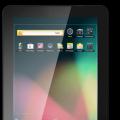category Audio circuits materials in the category Subcategory Circuits of switching and indication devices for audio signals and preamplifiers
This selector is designed to switch six signal sources at the input of the bass amplifier of the music complex. It is installed in front of the pre-amplifier.
The selector consists of two K561KP1 multiplexers and a six-channel switch-trigger on the K04KP020 microcircuit, which was used in the channel switches of domestic TVs 2,3 USTsT.
Selector circuit
Trigger К04КП020 is included according to the standard scheme. Six separate buttons S1 .... S3 are connected to it, with the help of which the desired channel is selected. The microcircuit itself works in such a way that when you press each button, logical "zeros" appear on the corresponding pins.
For example: press the button S1. It is connected to cell "1" (pin 6). Zero "appears on the corresponding cells: pin 2, 1 (in this case, the VD1 LED will light up) and pin 3.
If you press, for example, on the S3 button, then "Zero" will appear on pins 24, 23 and 25.
Moreover, this position of the trigger will persist as long as you like as long as there is power on the microcircuit.
Thus, we have three sets of outputs that can control specific functions: one of them switches the light indication, the second set controls multiplexers (which, in general, switch signal sources) and the third set can control the power supply of individual devices - for example, turn on a tape recorder, tuner, DVD player and so on.
One of these possible mains power control circuits is shown in the figure: it is a VT1 transistor and a P1 relay. The author does not recommend using a triac as a key switch, since they can interfere with the signal.
Any relay can be used, the main requirement is the actuation voltage of 12 Volts, and the power of the contacts is selected based on the switched load.
A stereo amplifier is rarely used with only one signal source; in order to quickly switch between different signal sources, it is desirable that the stereo amplifier has several switchable inputs.
In the simplest case, the inputs can be switched by a mechanical switch. But the reliability of a mechanical switch is very relative, its contacts corrode and at some point there are noises, often associated with mechanical stress.
In the very bad case even acoustic Feedback at which vibration from work acoustic systems transmitted to a worn mechanical switch, the contacts of which are rattling.
In this sense, an electronic switch is much more reliable. The figure shows a diagram of a simple electronic switch for three inputs of a stereo amplifier, with quasi-sensor control and LED indication of the input on.
Channel selector circuit
The circuit consists of a control device made on a D1 microcircuit and an electronic switch on a D2 microcircuit.
Rice. 1. Schematic diagram electronic switch of inputs for stereo amplifier power.
The circuit on the D1 microcircuit is a well-known three-phase RS-flip-flop circuit, implemented on the K561LA7 microcircuit. Changing the state of the trigger is carried out by buttons S1-S3, supplying logical zeros to its three inputs (active level - logical zero). Accordingly, there are three outputs (the active level is also zero).
A three-phase flip-flop can take three states, each of which has a logic zero on only one of its outputs. Accordingly, at the output of the element D1.1, D1.2 or D1.3. The trigger state is indicated by HL1-HL3 LEDs connected to its outputs through VT1-VT3 transistor switches.
The keys are made on transistors p-p-p structure, so they open with logical zeros coming to their bases from the outputs of the logic elements through the resistors R4-R6.
The electronic switch is made on a D2 microcircuit of the K561KP1 type. The microcircuit contains two switches for two directions and four positions, controlled by a digital code coming to the control inputs. The control code is digital and two-digit. That is, there are four positions "00", "01", "10" and "11" in total.
Accordingly, channels "0", "1", "2" and "3" are opened. To control the switch, logic levels are taken from only two outputs of the three-phase trigger on D1. As a result, in various states of the trigger on D1, codes "01", "10" and "11" are obtained.
This is enough to control the K561KP1 microcircuit to switch to three positions ("1", "2" and "3").
Input signals from three different signal sources go to paired connectors X1, X2 and X3. Each of them is a pair of coaxial tulip sockets, now widely used in various audio and video technology.
The output is the same X4 connector, but in practice, if the input switch is placed inside the stereo amplifier, this pair of X4 may not exist, just from pins 13 and 3 the signal is fed through shielded cables to the input of the preliminary ULF.
Details and connection
The K561KP1 microcircuit can switch both digital and analog signals. But, when switching analog signal you need it to be between the poles of the power supply, preferably in the middle (with minimal distortion of the audio signal).
Therefore, the second pin of the minus power supply of the keys (pin 7), which is usually connected to the common minus of the power supply, is here connected to the negative power supply (-5V). Thus, the power supply to the switch is bipolar.
There are no problems with this, since preliminary ULFs are usually made according to circuits on an op-amp, also powered by a bipolar source. If the source voltage is more than ± 7V, you need to supply power to the circuit through step-down stabilizers, for example, on the 7805 integrated stabilizer, make a + 5V source, and negative on the idle parametric stabilizer from a 4.7-5.6V zener diode and a resistor. LEDs HL1-HL3 - any indicator, for example, AL307 or their analogs.
Selector of inputs for the amplifier on the relay (DIY).
Various types of selectors are used to switch multiple input signals to a power amplifier without constantly juggling the cords. Below is a schematic diagram of such a selector; relays for a voltage of 12 volts are used as switching elements in it. The circuit is capable of switching 4 stereo sources sound signal... The RCA and relay input connectors are located on one small board, which reduces noise and uses fewer shielded cables. The selection of the inputs is carried out by a miniature 4-way switch. The rectifier and the filtering capacity of the power supply are also located on the board. The schematic diagram of the selector is shown below:

The power connector is supplied with an alternating voltage of 9 ... 12 Volts from a step-down transformer. In the diagram, after the rectifier, we see a resistor R * labeled 0R or more. This resistance is needed to limit the current when using transformers with a higher voltage than 9 Volts. When applying an alternating voltage of 9 volts, a jumper is simply placed. When a 12-volt change is applied after the rectifier and smoothing capacitance, 16.92 Volts will turn out, and this is already a bit too much for a 12-volt relay, we put a current-limiting resistor. We estimate the nominal value using the formula: 16.92-12 / relay coil current.
The board configuration looks like this:

In the figure, the yellow dot under the resistor R * indicates the place where the droshky is cut in the case of a current-limiting resistor.
LAY6 Input Relay Selector PCB:
Photo view of the LAY6 format selector board:
RCA stereo jack - 4 pcs.
Relay 12 Volt HK19F-DC12V-SHG - 4 pcs.

Link to product page
Gallet switch for 4 positions - 1 pc.
Connector 5Pin (2.54mm) for connection of a female switch - 1 pc.
1 x 2Pin Bolt Connector (Power Connection)
3Pin connector (connecting the selector output to the amplifier input) - 1 pc.
Imported diode assembly type W04, W06 - 1 pc.
You can also put diode assemblies such as DB102, DB103 or the like on the board.
Electrolyte capacitor 470 ... 1000mF / 25-35V - 1 pc.
Diode 1N4001 (parallel to the relay windings) - 4 pcs.
5mm LED - 4 pcs.
Resistors in the 1 kOhm LED circuit - 4 pcs.
Current limiting resistor 200R 0.25W - 1 pc.
Connectors Input1 - Input4 - 3Pin 2.54mm - 4 pcs. This is if you will not use standard RCA input connectors, but external ones, which are installed not on the selector board, but on the amplifier case.
And one more Vcc connector - for supplying a constant supply voltage to the board, in this case the change is not connected, and the diode assembly does not need to be soldered.
Most inexpensive domestic and imported TVs have only one pair of audio-video inputs, while the "home video system" is now rarely limited to one video player, and in order to connect a DVD player, a game console to such a TV, you have to switch all the time plug into these connectors.
The additional audio-video inputs on the front panel available in some TVs do not solve the problem, since they are connected in parallel with the main one and to send a signal to them, you still need to disconnect the equipment from the main connector.
If your TV has a tuner with analog band switching (three power outputs are switched by three transistor switches controlled by the control controller), you can make up to three inputs switched using the remote control on the TV.
The fact is that the radio channel of most TVs, when switching to the "AV" mode, does not turn off, but only turns off at a low frequency. At the same time, there are video and audio signals of the TV program at the output connectors. This means that the preselection of the TV program is saved, and with it the selection of the tuner band.
The idea is to do three additional settings for three programs running in different ranges and assign their numbers to video inputs. For example, if ten TV programs are received in your area, then we simply make three additional settings (No. 11, No. 12, No. 13) for any of the programs operating in different bands and assign their numbers to homemade video inputs (for example, 1st input - program No. 11, 2nd - program No. 12, 3rd - program No. 13).
And you can switch inputs using transistor keys and electromagnetic relays, collecting simple scheme shown in the figure.
The V IN and A IN connectors are standard connectors routed to the rear panel of the TV, they are not switchable. The other three pairs of connectors are additional, they are switched by electromagnetic relays K1-K3. To control the VT1-VT3 keys, voltages are supplied to their bases from the outputs of the tuner range switch (from the tracks going to the BU, VN and BL terminals of the tuner).
This circuit uses small-sized relays of the BT24S type, with 24V windings and two contact groups. At rated voltage on a 24V winding, these relays work well at reduced voltage up to 12-15V. This allows the power supply of the UMZCH TV to be used to power the windings, the voltage of which is different models can be from 12 to 20V.
Additional connectors are mounted directly on the back of the TV cabinet. Relays and keys are mounted side by side in a volumetric manner on a specially installed contact plate. All three relays are assembled into one block and glued together with the bodies and to the rear wall of the TV (glue of the "Moment-1M" type). Connection to main input connectors. - a two-wire shielded wire, with a TV circuit, - a five-wire ribbon cable.
They switch the inputs as follows - turn on the program to which the input number is assigned, and then press "AV". If you need to change the input, turn on “TV”, then the program to which the number of the required input is assigned, then “AV” again.
This project is implemented on a more powerful controller - atmega8. It already has 7 commands, an additional command has appeared - power off and on.
I will briefly explain the principle of operation of the device: Pressing the CD DVD AUX or TUNER buttons, the relay of this input turns on and the LED of this input blinks 3 times, then it is constantly on.
By pressing the POWER AC1 or AC2 buttons, the corresponding relay is switched on. Pressing it again deactivates the current relay of the output (triggering nature of the relay).
If you program the commands from the remote control - by pressing the remote control buttons, the relay and the module indication will work in the same way.
Now the module supports commands from the remote control (universal protocol). In order to operate the remote control, you just need to program its buttons in the menu.
Entering the programming mode: We hold down the sel button and press the module button of interest to us. The LED for the selected command will flash. And by pressing the button on the remote control, the command will be captured. If the capture is successful, the module LED will blink again. And this is how all the commands of the module are programmed.
To erase the programmed commands, you need to hold down the sel button for a long time (about 10 seconds), after erasing all input LEDs will blink.
This module was tested on 5 different consoles, here they are in the photo:

He worked great with these remote controls! Unfortunately, this firmware version does not support SONY SIRC 12bit protocol commands ... In the future I plan to definitely solve this problem! Since I will use this algorithm in my other projects.
To program the controller, we need a programmer for AVR microcontrollers. From the factory, this MK is programmed for a clock frequency of 1 MHz from an internal oscillator. This frequency does not suit us, so we will have to climb into the fuse of the microcontroller bits. We need to change the fuse bits responsible for clocking.
Can be tuned to an internal 4 MHz oscillator, or can be tuned to an external 4 MHz crystal. For reliable operation of the decoder, I STRONGLY RECOMMEND to tune the MK to an external quartz resonator with a frequency of 4 MHz.
For this purpose, the fuses must be written as follows: CKSEL 3 ... 0 = 1111, all other values do not need to be touched.
In this version source I do not spread it, since the decoder algorithm is closed!
Those who have assembled this device, I ask you to write in the comments which remote control you managed to make friends, and which failed.

Updates:
Version 1.1:
- introduced support for Sony SIRC protocol and improved data encoding / decoding algorithm.
Version 2.0:
- when power is applied, the device is in standby mode, a separate power indication has appeared, when the power is on, the LED is on. When the power is off, the LED blinks.
When the power is turned off from the remote control or the button, all inputs and outputs are blocked and disabled. When the power is turned on, the last current setting is saved and after a second, two I / O are activated.
Version 3.1:
- it became possible to adjust the volume of the "motorized regulator"
An additional "mute" button has been added and 3 additional commands for remote control are: increase the volume, decrease the volume and silence mode.
In order to program commands, you need to hold down sel and hold down mute and send a command from the remote control. This is mute mode.
For "volume +" you need to hold down sel, cd, tuner and send a command from the remote control.
For "volume -" you need to hold down sel, cd, aux and send a command from the remote control.
After that, you can use the remote control.
A new menu service has appeared. To enter, when turning on the power, hold down the sel button for 5 seconds until all 4 indication LEDs light up. Then use the same button to select mode 1 or 2. Press the button and wait until all the LEDs flash again, release the button.
These modes allow you to adjust the desired remote control as accurately as possible for this device... Mode 1 is sharpened closer to Sony, and mode 2 is sharpened closer to Panasonic REC-80.
Updated schema:

Below you can download firmware, project in and files printed circuit boards in the format
List of radioelements
| Designation | Type of | Denomination | Quantity | Note | Shop | My notebook |
|---|---|---|---|---|---|---|
| U1 | MK AVR 8-bit | ATmega8 | 1 | Into notepad | ||
| U2 | IR receiver | TSOP17xx | 1 | Into notepad | ||
| U3 | Linear regulator | LM7805 | 1 | Into notepad | ||
| Q1-Q5 | Bipolar transistor | MJE340 | 5 | Into notepad | ||
| D1-D6, D14, D16, D17 | Rectifier diode | 1N4148 | 8 | Into notepad | ||
| D7-D15 | Light-emitting diode | 8 | Into notepad | |||
| C1, C2 | Capacitor | 15-22 pF | 2 | Into notepad | ||
| C3 | Capacitor | 100 nF | 1 | Into notepad | ||
| R1 | Resistor | 10 kΩ | 2 | Into notepad | ||
| R2 | Resistor | 2 kΩ | 3 | Into notepad | ||
| R3, R5, R8, 8xR9 | Resistor | 1 kΩ | 11 |




